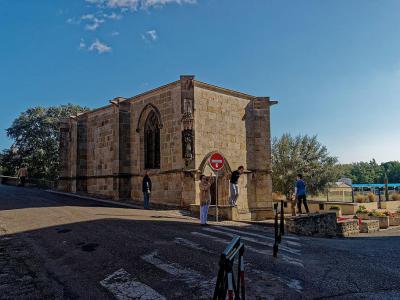
Chapelle Notre Dame de la Santé (Our Lady of Health Chapel), Carcassonne
The Our Lady of Health Chapel stands as a testament to Carcassonne’s layered history and enduring faith. Located at the entrance to the Old Bridge (Pont-Vieux), this Catholic chapel was initially constructed around 1500, though its roots trace back to a lost 14th-century structure built in 1397 to serve pilgrims on the Way of Saint James.
The chapel's story is closely tied to local benefactors. In 1497, Pierre Jauffre, a wealthy Carcassonne merchant, left funds for the construction of a small church. Later, in 1527, Jean de Saix bequeathed 4,000 pounds to expand the chapel and create a hospital for plague victims. His contribution is immortalized in the chapel’s sculpted façade, which features a balustrade adorned with gargoyles. Although the coat of arms of de Saix has largely faded, traces of his influence remain in the richly detailed ogival portal.
The chapel’s design reflects a blend of Flamboyant Gothic and Renaissance elements. Its vaulted interior features intricate lierne and trefoil patterns, and the polygonal apse, illuminated by lancet windows, lends an ethereal glow to the space. Over the centuries, additions such as a sacristy towering above the Aude River and extensions toward the riverbank were made, reflecting its evolving function.
During the French Revolution, the chapel faced a period of decline, seized as national property in 1796 and converted into a private residence. Much of its original decoration was lost, and structural changes, including the addition of a floor, altered its appearance. However, Bishop François Alexandre Roullet de La Bouillerie restored the chapel in 1857, reinstating its role as a place of worship.
Two notable statues of the Virgin and Child grace the chapel: a 16th-century white marble statue, preserved during the Revolution, and a 19th-century polychrome version by sculptor Auguste Perrin. Both serve as enduring symbols of the chapel's spiritual legacy.
The chapel's story is closely tied to local benefactors. In 1497, Pierre Jauffre, a wealthy Carcassonne merchant, left funds for the construction of a small church. Later, in 1527, Jean de Saix bequeathed 4,000 pounds to expand the chapel and create a hospital for plague victims. His contribution is immortalized in the chapel’s sculpted façade, which features a balustrade adorned with gargoyles. Although the coat of arms of de Saix has largely faded, traces of his influence remain in the richly detailed ogival portal.
The chapel’s design reflects a blend of Flamboyant Gothic and Renaissance elements. Its vaulted interior features intricate lierne and trefoil patterns, and the polygonal apse, illuminated by lancet windows, lends an ethereal glow to the space. Over the centuries, additions such as a sacristy towering above the Aude River and extensions toward the riverbank were made, reflecting its evolving function.
During the French Revolution, the chapel faced a period of decline, seized as national property in 1796 and converted into a private residence. Much of its original decoration was lost, and structural changes, including the addition of a floor, altered its appearance. However, Bishop François Alexandre Roullet de La Bouillerie restored the chapel in 1857, reinstating its role as a place of worship.
Two notable statues of the Virgin and Child grace the chapel: a 16th-century white marble statue, preserved during the Revolution, and a 19th-century polychrome version by sculptor Auguste Perrin. Both serve as enduring symbols of the chapel's spiritual legacy.
Want to visit this sight? Check out these Self-Guided Walking Tours in Carcassonne. Alternatively, you can download the mobile app "GPSmyCity: Walks in 1K+ Cities" from Apple App Store or Google Play Store. The app turns your mobile device to a personal tour guide and it works offline, so no data plan is needed when traveling abroad.
Chapelle Notre Dame de la Santé (Our Lady of Health Chapel) on Map






Sight Name: Chapelle Notre Dame de la Santé (Our Lady of Health Chapel)
Sight Location: Carcassonne, France (See walking tours in Carcassonne)
Sight Type: Religious
Sight Location: Carcassonne, France (See walking tours in Carcassonne)
Sight Type: Religious
Walking Tours in Carcassonne, France
Create Your Own Walk in Carcassonne
Creating your own self-guided walk in Carcassonne is easy and fun. Choose the city attractions that you want to see and a walk route map will be created just for you. You can even set your hotel as the start point of the walk.
Carcassonne Introduction Walking Tour
Nestled in the picturesque region of Occitanie in southern France is the captivating city of Carcassonne.
The name "Carcassonne" is believed to have originated from the Gallic word "Carsac," referring to a fort settlement that was later fortified by the Romans who occupied the area in the 1st century BC.
A legend suggests another, more colorful version of the name,... view more
Tour Duration: 2 Hour(s)
Travel Distance: 2.5 Km or 1.6 Miles
The name "Carcassonne" is believed to have originated from the Gallic word "Carsac," referring to a fort settlement that was later fortified by the Romans who occupied the area in the 1st century BC.
A legend suggests another, more colorful version of the name,... view more
Tour Duration: 2 Hour(s)
Travel Distance: 2.5 Km or 1.6 Miles
Medieval City of Carcassonne Walking Tour
A pig full of wheat was thrown off the battlements. The lady commanding the fortress was a Muslim. The besieging Christians knew Muslims do not eat pig. What is more, the defenders must have plenty of food if they could feed wheat to a pig and throw it over the walls. The siege had lasted five years. The attackers were starving. They left.
Many stories are told about the fortified medieval... view more
Tour Duration: 1 Hour(s)
Travel Distance: 1.2 Km or 0.7 Miles
Many stories are told about the fortified medieval... view more
Tour Duration: 1 Hour(s)
Travel Distance: 1.2 Km or 0.7 Miles


